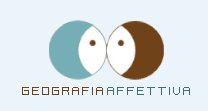
geografia affettiva (geanet) is about composing and
mapping the interrelation of life and how to provide each
member of a community/association/gang/group/band/etc.
with a tool to interact with the geanet-system and the other:
to in-form ("to put into form") his/her personal plan(s) and
map(s) as part of a whole visualised, multi-layered and
dynamic network.
using the technology of the telephone networks (cellular
phone networks/internet), the application provides the
possibility to translate his/her physical/spatial and
intellectual/spiritual moves (and the motivations behind them)
onto a web platform. this translation and mapping happens
directly when the member sends location- and (e)motionbased
information (sms, web-online-editing) about individual
spots, moments, movements, ways and stays.
the visual basics of geanet are maps/plans. each single
member develops his/her individual cartography by working
with the above mentioned technologies: his/her way in
space, in-between the poles of interest and affection
become digital and visual because they evolve into a
concrete physical state of being related. "individual
landscape" becomes "condividual datascape" and "I" takes
the shape of a knot in the networks of "yous".
hence geanet includes as a central feature, the possibility to
overlap these individual maps and layers of information: this
way, a member is able to create new kinds of versatile maps
based on information derived from the individual meta-data
of the community. his/her specific motivations, routes and
destinations draw spots, lines, curves and intersections. a
hyper-linked multi-layer-pattern of "all" ways and stays of a
community composed by the individual movements and
"meetings" of people, their imagination, wishes and
emerging projects:
a transpersonal cartography > an affective geography.






